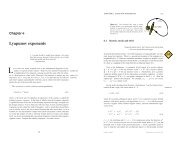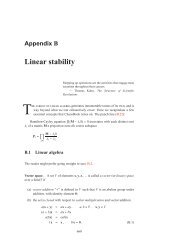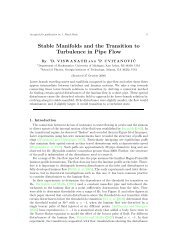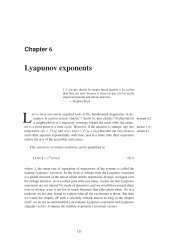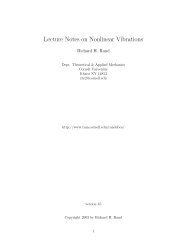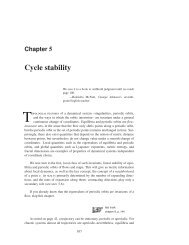10 Circle Maps: Irrationally Winding - Center for Nonlinear Science
10 Circle Maps: Irrationally Winding - Center for Nonlinear Science
10 Circle Maps: Irrationally Winding - Center for Nonlinear Science
Create successful ePaper yourself
Turn your PDF publications into a flip-book with our unique Google optimized e-Paper software.
<strong>10</strong>. <strong>Circle</strong> <strong>Maps</strong> 23<br />
<strong>for</strong>mally identical to those used <strong>for</strong> description of dynamical strange sets[22], the<br />
deep dierence being that here the cycles are not dynamical trajectories in the<br />
coordinate space, but renormalization group ows in the function spaces representing<br />
families of dynamical systems. The \cycle eigenvalues" are in present<br />
context the universal quadratic irrational scaling numbers.<br />
In the above investigations we were greatly helped by the availability ofthe<br />
number theory models: in the k = 0 limit of (1) the renormalization ow isgiven<br />
by the Gauss map (6), <strong>for</strong> which the universal scaling p reduce to quadratic<br />
irrationals. In retrospect, even this "trival" case seems not so trivial and <strong>for</strong> the<br />
critical circle maps we are a long way from having a satisfactory theory. Symptomatic<br />
of the situation is the fact that while <strong>for</strong> the period doubling repeller<br />
D H is known to 25 signicant digits[54], here we can barely trust the rst three<br />
digits.<br />
The quasiperiodic route to chaos has been explored experimentaly in systems<br />
ranging from convective hydrodynamic ows[40] to semiconductor physics[41].<br />
Such experiments illustrate the high precision with which the experimentalists<br />
now test the theory of transitions to chaos. It is fascinating that not only that<br />
the number-theoretic aspects of dynamics can be measured with such precision<br />
in physical systems, but that these systems are studied by physicists <strong>for</strong> reasons<br />
other than merely testing the renormalization theory or number theory. But, in<br />
all fairness, chaos via circle-map criticality is not nature's preferred way of destroying<br />
invariant tori, and the critical circle map renormalization theory remains<br />
a theoretical physicist's toy.<br />
Acknowledgements<br />
These lectures are to large extent built on discussions and/or collaborations<br />
with R. Artuso, M.J. Feigenbaum, P. Grassberger, M.H. Jensen, L.P. Kadano,<br />
A.D. Kennedy, B. Kenny, O. Lan<strong>for</strong>d, J. Myrheim, I. Procaccia, D. Rand, B.<br />
Shraiman, B. Soderberg and D. Sullivan. P.C. thanks the Carlsberg Fundation<br />
<strong>for</strong> the support.<br />
References<br />
[1] S.J. Shenker and L.P. Kadano, J. Stat. Phys. 27, 631 (1982)<br />
[2] S.J. Shenker, Physica 5D, 405 (1982)<br />
[3] P. Cvitanovic and J. Myrheim, Phys. Lett. A94, 329 (1983) Commun. Math.<br />
Phys. 121, 225 (1989)<br />
[4] For a nice discussion of physical applications of circle maps, see <strong>for</strong> example<br />
refs. [5].<br />
[5] M.H. Jensen, P. Bak, T. Bohr, Phys. Rev. Lett. 50, 1637 (1983) Phys. Rev. A30,<br />
1960 (1984) P. Bak, T. Bohr and M.H. Jensen, Physica Scripta T9, 50 (1985),<br />
reprinted in ref. [6]



